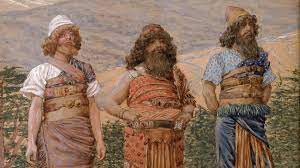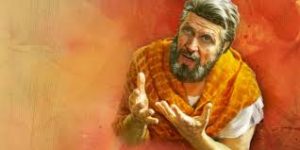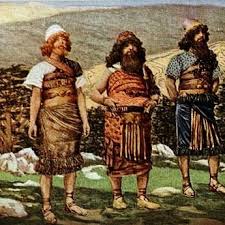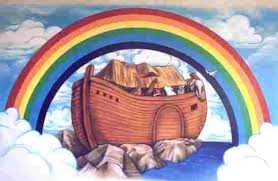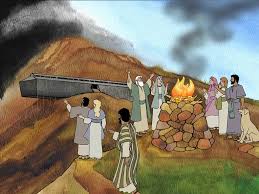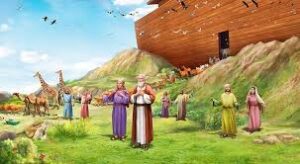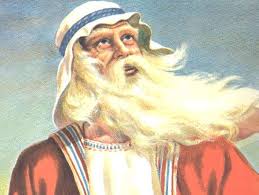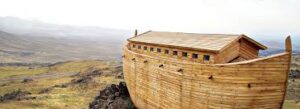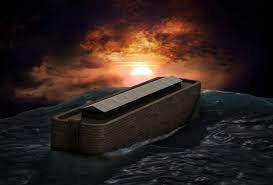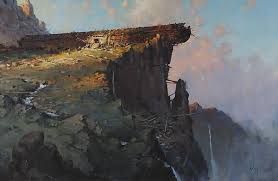Dh – The Line of Japheth 10: 2-5
The Line of Japheth
10: 2-5
The line of Japheth DIG: Why is Japheth mentioned first of the three brothers? How many nations resulted from the line of Japheth? What was the occupation of a majority of Japheth’s descendants? How did ADONAI show His love by keeping His covenant with Noah? In what sense did Japheth dwell in the tents of Shem?

We begin with the eldest of Noah’s three sons, Japheth. He is mentioned first, because he was the eldest, and then Ham, so that the genealogy of Shem, the youngest, can lead to Abraham without a break. Japheth’s descendants became the Indo-European people who settled east into parts of Asia, north into Europe, and westward into Spain. The line of Japheth produced the Caucasian and Oriental races. He had seven sons (10:2) seven grandsons (10:3-4), and fathered fourteen nations (to see link click Ae – The Number Seven).
Gomer fathered the Cimmerians who located southwest of the Black Sea. After being defeated by the Assyrians they settled in the area between Armenia and Cappadocia (Ezeki’el 38:2 and 39:6). They ultimately settled in places like Germany, France and Wales.
Magog was the second son. He located between the Black and Caspian Seas in what is now southern Russia. He is associated with both Meshech and Tubal in Ezeki’el 38:2 and Gomer and Togarmah in Ezeki’el 38:6. The Scythians, the Slavs, Russians, Bulgarians, Bohemians, Poles, Slovaks, and the Croatians came from Magog.
Madai was the third son. His descendants are mentioned in Second Kings 17:6, 18:11: Isaiah 13:17, 21:2; Jeremiah 25:25, 51:11 and 28. The Indians and the Iranic races such as the Medes, Persians, Afghans, and the Kurds all came from Madai, who located southwest of the Caspian Sea.
Javan was the fourth son and is pronounced Yavan in Hebrew. It is the source of the name Ionia from Homer’s Iliad and refers to the Hellenic race. These people settled along the coast of Asia Minor, which is Greece. They are mentioned in Isaiah 66:19 where they are connected with Tarshish and Tubal, and Ezeki’el 27:13 where they are connected with Meshech and Tubal. There is a Greek legend that says that Eipetos is the father of the Greeks and Eipetos is the Greek form of Japheth. So the Greeks, Romans, French, Spanish, Portuguese, and Italians all came from Javan.
Tubal was the fifth son and his descendants are the Tabali of the Assyrian inscriptions. They lived in east Asia Minor and included areas of Russia and as far north as Tobolsk on the Tobol River.
Meshech was the sixth son and are the Mushki of the Assyrian cuneiform inscriptions. They are also mentioned in Egyptian literature. They located between the Black and Caspian Seas. The territory they settled was Russia, and they are always mentioned in conjunction with Tubal as seen in Ezeki’el 27:13, 32:26, 38:2-3 and 39:1.
Tiras was the last son (10:2). The Thracians, the Teutons, and the Anglo-Saxon race, the English people, came from Tiras. Seven more came from these seven.
Three northern tribes came from the sons of Gomer and the grandsons of Japheth: Ashkenaz was the first son of Gomer. The Jews identified Ashkenaz with Germany and, to this day, German Jews are called the Ashkenazi.185 Their territories included Germany, Skandia, Sexon, Denmark and Armenia. They are mentioned in Jeremiah 51:27 in conjunction with Ararat and Minni.
Riphath was the second son of Gomer. In First Chronicles 1:6 his name is spelled Diphath because the r and the d are very much alike in Hebrew. They located on the southern edge of the Black Sea.
Togarmah was the third son and the ancestor of the Armenians, as they themselves claim (10:3). Other references to them are in Ezeki’el 27:14, where they were noted for exporting horses to Tyre, and in Ezeki’el 38:6, where they are part of the LORD’s army.
Then, the sons of Javan or Yavan, the grandsons of Japheth, were related to the Greeks: Elishah was the first son of Javan. They located in Cyrus and Crete.
Tarshish was the second son of Javan and means refinery. His descendants were located in southwestern Spain. Other references to them are found in First Kings 10:22, which says they were exporters of gold, silver, ivory, apes and baboons; in Isaiah 23:1, where Tyre are connected with ships; in Jeremiah 10:9 where they were exporters of silver; Ezeki’el 27:12 where they were connected with Tyre and the export of silver, iron, tin and lead. This was the destination of Jonah (Jonah 1:3) and was also the place of Solomon’s trading ships (Second Chronicles 9:21).
Kittim was the third son mentioned, which is the Phoenician part of Cypress. Other references are in Numbers 24:24 which are associated with ships; Isaiah 23:1,where Tyre is destroyed, and Ezeki’el 27:6, where it is described as an island.
And Rodanim, or as sometimes pronounced Dodanim because the r and the d sound so much alike in Hebrew (First Chronicles 1:7), was the fourth son. They located in Greece and Macedonia (10:4).
From these the maritime peoples spread out into their territories. This is stated to tell how it came about that the people were scattered so soon after the Flood, and it links up with the story of the Tower of Babel, which explains how the different languages arose. Moreover, it shows how ADONAI in His love kept His covenant with Noah and did not destroy his descendants. A majority of Japheth’s descendants made their living on the sea, in one way or another. They spread out both east and west, going as far as Europe in the west and Persia, India and most of Asia in the east. They spread out over so much territory, that they fulfilled the prophecy of 9:27 where Noah said: May God extend the territory of Japheth. Then they were divided by their clans within their nations and fourteen nations came from Japheth (10:5a). This shows they had some kind of social structure. The time span given here is three generations within fourteen nations. Each of these clans had its own language (10:5b). This proves that this was written after the dispersion of Chapter 11. These northern tribes did not figure predominantly in Israel’s history, but occur frequently in prophetic writings (Ezeki’el 27, 37-39).186
As for Japheth and his descendants, the complete understanding of this prophecy can be seen in the translation of his name, which is beauty. In other words, the prophecy could be summarized, “Let Isra’el absorb all the beauty and cultural richness that the nations have to offer.” Since the descendants of Jatheth constitute the majority of the nations of the world, then out of those nations, ADONAI would gather a spiritual remnant who would believe in the God of Isra’el through the Messiah. Romans describes these non-Jewish believers as those who are grafted into Isra’el (see the commentary on Romans Cz – The Illustration of Isra’el’s Future). Furthermore, Ephesians 2:12 describes them as being part of the commonwealth of Isra’el. In this sense, then, we could say that Japheth would dwell in the tents of Shem (9;27).



